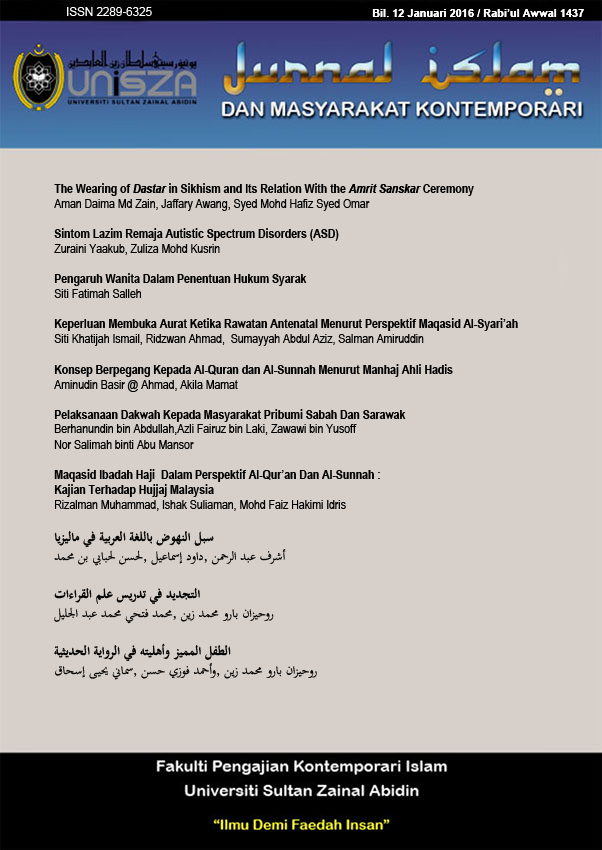The Wearing of Dastar in Sikhism and Its Relation With the Amrit Sanskar Ceremony
DOI:
https://doi.org/10.37231/jimk.2016.12.0.144Abstract
In the religion of Sikh, wearing the turban or the dastar is a religious practice that is a symbolic proof of their faith to the Sikh Guru’s teachings and their holy book. The dastar carries its own distinguished characteristics in terms of the way it is worn, its measurements and colours. It completes the Sikh dresscode or uniform, known as Panch Kekaar or the 5Ks, that is an integral part of their identity. Nevertheless, not all Sikh followers wear the dastar. This depends on individual’s willingness to undergo a baptism ritual, known as the amrit sanskar. The dastar-wearing Sikhs who have requested for amrit are called amrit-dhari; they are true Sikh followers who adhere to the teachings of their Sikh teachers. One of the objectives of this study is to provide information to the multi-racial society in Malaysia, especially the Muslim society, concerning the wearing of dastar in Sikhism and its relation with baptism.  Through this information, it is hoped that a society that is tolerance and have mutual respect for each other, irrespective of race and religion, as aspired by the concept of 1Malaysia, is borne. In this study, the textual analysis method is adopted to retrieve information on the dastar and the amrit sanskar ritual. In addition, various references in relation to the Sikh religion were also made. Â
Â
Keywords:Â Dastar, Sikhism, amrit sanskar, panch kekaar
References
References
__________. (1993). The New Encyclopedia Britannica. Vol 27. Chicago : Universiti Chicago.
al-Alusiy, H.H. (2001). al-Sikh fi al-Hind. al-Qahirah : Dar al-Dauliyyah li al-Istimarat al-Thaqafiyyah.
Bailey, J. (1992). Gods and Men Myths and Legends from the World’s Religions. Oxford University Press, p.139.
Banerjee, A.C. (1983). The Sikh Gurus and the Sikh Religion. New Delhi : Munshiram Manoharlal Publishers Pvt. Ltd.
Banerjee, I. (1962). Evolution of the Khalsa. Vol. 2. Calcutta : A. Mukharjee & C.O Private. Ltd.
Buck, M.C.H. (1977). Faith, Fairs and Festivals of India. Asian Educational Services.
Burke, T.P. (2004). The Major Religions : An Introduction With Texts. Second Edition. Oxford : Blackwell Publishing.
Christine, L.P. (2007). Conversion in a Post-Modern Context. Swedish Missiological Themes. Sweden : Swedish Institute of Mission Research, 95 (4).
Dali, A.M. (2002). Gerakan Politik di Tanah Melayu Pada Era Perang Dunia I Dengan Tumpuan Kepada Masyarakat Sikh. Seminar Komuniti Sikh di Malaysia. Organizer : ATMA, UKM, 21st January.
Darshan S.G. (2009). Sikh Community in Malaysia. Petaling Jaya : MPH Group Publishing Sdn. Bhd.
Field, D. (1976). The Religion of the Sikhs. Delhi : Ess Ess Publications.
Jain, S.C. (1985). A Panorama of Sikh Religion & Philosophy. Delhi : Bahubali Publications.
Mansukhani, G.S. (1982). Aspects of Sikhism. New Delhi : Army Educational Stores.
McClatchy. (2009). North Texas College Students Try on Turbans, New Perspective. Tribune Business News, Washington.
Mcleod, H. (2008). The Five Ks of the Khalsa Sikhs. Journal of the American Oriental Society, 128 (2), 338-340.
Mschafer, S. (2010). Sikh Soldier Allowed to Wear Turban. Spartanburg S.C. : Spartanburg Herald Journal.
Noss, J.B. (1980). Man’s Religions. New York : Macmillan Publishing Co., Inc.
Sabha, S.N.(1969). Ugama Sikh, Negeri Sembilan : Chang Litho Press.
Salim, A. (1985). Perbandingan Agama, Bandung : C.V. Diponegoro,
Sarjit, S.G. (2005). Peranan Gurdwara Dalam Pembentukan Identiti Sikh : Kajian Perbandingan. PhD Thesis, Bangi: Universiti Kebangsaan Malaysia.
Sarjit, S.G. (2007). Penyertaan Peranakan Punjabi Dalam program Pembangunan Komuniti: Kajian Etnografi di Kota Kinabalu, Sabah. Borneo Research Journal, Jabatan Pengajian Asia Tenggara, Vol 1.
Sarjit, S.G. (2008). Peranan Gurdwara Dalam Pembentukan Identiti Sikh di Malaysia: Antara Ideal dan Praktis. Akademika, 73, pp.27-50.
Savinder, K.G & Gopal, N.D. (2010). Understanding Indian Religious Practice in Malaysia. Journal of Social Sciences. 25(1-2-3), pp.135-146.
Teja, S. (n.d). The Religion of the Sikh Gurus. Amritsar: The Shiromani Gurdwara Parbandhak Committee.
United Sikhs Files Criminal Complaint Against Punjab Police for the Unlawful Removal of a Sikh’s Turban and Demands Accountability From the India Government. (2011). PR Newswire New York, March 31th.
Zain, A.D.M (2001). Lambang-lambang Agama Sikh di Kelantan: Suatu Kajian Kritis Menurut Ajaran Islam, Master’s Thesis, Bahagian Pengajian Usuluddin, Akademik Pengajian Islam, UM.
Zain, A.D.M, (2012). Perbandingan Dastar Dalam Agama Sikh Dengan Serban Dalam Agama Islam. Jurnal Islam dan Masyarakat Kontemporari, 5, pp.37-44.
Zain, A.D.M, Omar, S.H.S Othman, M.S. & Mohamed, H.A.B. (2011). Implementation of Panch Kekaar and Khalsa in Sikh Society in Kelantan, Malaysia. International Journal of Business and Social Science, 2(8), pp.276-282.
http://fateh.sikhnet.com/s/WhyTurbans#SikhIdentity. (2011). 7 June.
Downloads
Published
Issue
Section
License
Submission of an article implies that the work described has not been published previously (except in the form of an abstract or as part of a published lecture or academic thesis), that it is not under consideration for publication elsewhere, that its publication is approved by all authors and tacitly or explicitly by the responsible authorities where the work was carried out, and that, if accepted, will not be published elsewhere in the same form, in English or in any other language, without the written consent of the Publisher. The Editors reserve the right to edit or otherwise alter all contributions, but authors will receive proofs for approval before publication.
Copyrights for articles published in JIMK journals are retained by the authors, with first publication rights granted to the journal. The journal/publisher is not responsible for subsequent uses of the work. It is the author's responsibility to bring an infringement action if so desired by the author.





